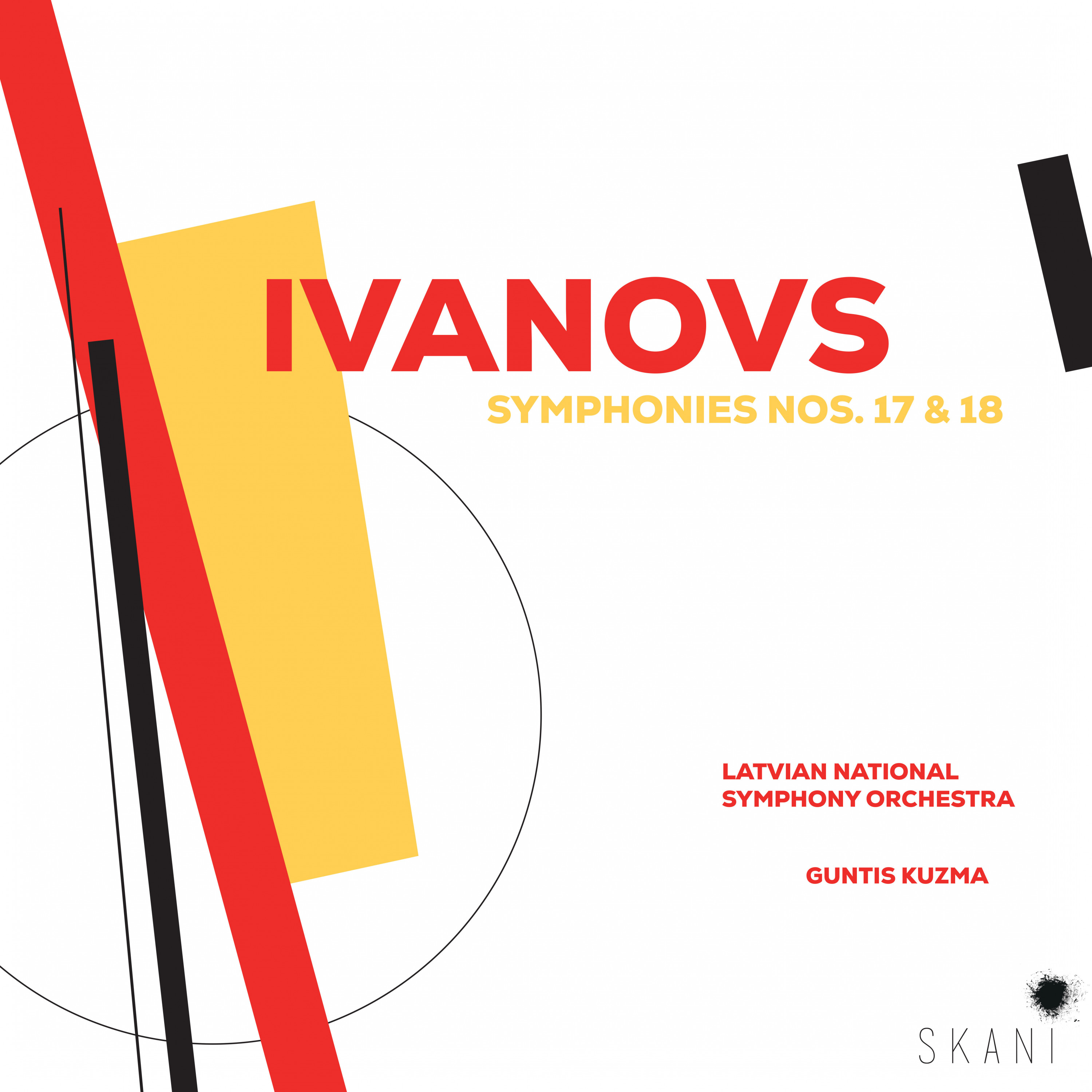Lovers of the orchestral music, and especially the symphonies, of Latvian composer Jānis Ivanovs will welcome this latest release from the Skani label featuring Symphonies 17 and 18. He composed twenty-one symphonies in all, though No. 21 remained unfinished at his death; it was completed and orchestrated by Juris Karlsons. So far, Skani have issued Symphonies 14 (2 performances), 15, 16 and 20 (2 performances). In 2004 Naxos released a disc of Symphonies 8 and 20, positively reviewed at the time by my colleagues Don Satz and Rob Barnett.
Ivanovs was the most significant and prolific Latvian symphonist of the second half of the 20th century. He was born in Preiļi in 1906, and when the First World War broke out his family fled to Russia, returning when hostilities ended. In 1924 he enrolled at the newly established Latvian Conservatory, studying conducting with Georg Schnéevoigt and composition with Jāzeps Vītols. He himself was a professor of composition there from 1944 until his death. He also worked as a sound engineer in the 1930s, and for many years was artistic director of Latvian Radio. He died in Riga in 1983.
Both Symphonies see their world premiere release in these 2022 studio recordings. Symphony No. 17, in four movements, dates from 1976. It reveals a “new romanticism” which came to inform his music. The opening movement begins and ends in a climate of calm and reflection, with beautiful transparent textures emitting a honeyed glow of sound. Four minutes in, the music begins to work up a hefty head of steam. The narrative remains agitated and vehement until calmness descends near the end. A brief five minute scherzo-like movement follows before the Adagio, the emotional heart of the Symphony. This glorious movement has a timeless quality, evoking a far-off land of dreams, wistful and melancholic. A boisterous, angular finale brings the work to a close.
A year later in 1977 Ivanovs penned his Eighteenth Symphony, again in four movements. It’s dedicated to the 60th anniversary of the Great October socialist revolution. The work is infused with memories of the two Great Wars, hearkening back to the Symphony No. 5 (1945), which also speaks of war but unfortunately became the victim of Zhdanov’s anti-formalist campaign. The first movement has a serious and solemn demeanour throughout. An energetic scherzo precedes a doleful Andante Tenebroso, described in the notes as an “elegiac requiem”. The long drawn-out lines of melody spell sadness and regret. The fourth movement works on a militaristic formula, grandiose yet with a sense of foreboding.
These are vital and highly engaging performances, registering a powerful impact. Guntis Kuzma has full measure of the character, idiom and contours of these rewarding scores and directs the orchestra in compelling soul-searching performances. The superb audio quality does the music full justice. It’s well-worth giving these symphonies a try.
Stephen Greenbank
www.musicweb-international.com 07/2022
_________________________
Jānis Ivanovs (1906-1983) was not only one of Latvia's most important composers, but also one of the greatest symphonists of the 20th century. Unfortunately, today he is completely overshadowed by his compatriot Pēteris Vasks, who is celebrated, rightly in my opinion, as the "voice" of his homeland. It may be because Ivanov's tonal language is more brittle and unpopular than Vasks' resonant sermons with their clear coordinates of light and dark, good, and evil, consolation and sorrow.
And so it is more than welcome that the Latvian label Skani has embarked on a complete recording of his 20 symphonies. Last year, the first recording of the projected cycle was released, featuring Symphonies 15 and 16. Now the same musicians have followed suit and present the numbers 17 and 18. And once again the result inspires all along the line! Conductor Guntis Kuzma and the Latvian National Orchestra have an unmistakable feeling for the muted colours of this music, painted as it were with sand and earth, which does not flirt in any direction, neither in the socialist-realist nor in the national-romantic direction, nor as is often the case with Shostakovich, in the sarcastic direction.
Without being avant-garde in the true sense of the word, Ivanov's symphonies are always at the height of their time, regardless of whether they reflect the Romantic legacy, as in the Seventeenth, or whether they mourn it, as in the Eighteenth, here also with modernist means such as dodecaphony. The Latvian musicians' readings are authentic in the true sense of the word.
Burkhard Schäfer
FONO FORUM, 11/2022
_________________________
Glowering textures, luminosity, drama, tenderness. It's all there in the symphonies of Jānis Ivanovs (1906-83), a Latvian composer, and these excellent performances by the Latvian National Symphony Orchestra under Guntis Kuzma absolutely show these pieces at their best.
Ivanovs studied at the Latvian State Conservatory (Riga), later teaching there and achieving the rank of Professor. He composed 21 Symphonies (the final one was left incomplete at his death and has been completed by Juris Karlsons). [..] Interstingly, Ivanovs also worked for some time as a sound engineer; he also directed Latvian Radio for some time.
There is a muscular sense of adventure to the heroic first movement of Symphony No. 17 in C-Major (1976): think a mix of Scriabin and Zemlinsky, but with a touch of Latvian darkness. It is a complex movement - a lot tends to go on at the same time - so all credit to Kuzma for guiding us through, and to the Latvian National Symphony Orchestra for dealing so well with Ivanov's demands.
The keening phrases and dark tenderness of the third movement Adagio are quite unlike anyone else, a product of his so-called "New Romanticism"; and come in high contrast to the spiky, angular, dissonant second movement Allegro. [..]
Moments of light in the finale are riveting, against those slightly brash woodwind one often heres from these territories that add a really piquant touch. And then there's the final moments of illumination (almost a Star Trek moment, to my ears!!).
The glowing opening of Symphony No. 18 (1977) begins a war symphony written while the Soviet nation prepared for the 60th anniversary of the Great October Uprising. One can hear anger in the more militaristic moments of the first movement (at least in this performance), tempered by those luminous winds.
Kuzma clearly understands this music, giving it propulsion and also power, both very much in evidence in the second movement Allegro with its stuttering accents and swirling woodwinds.
There is a Malerian integrity to the slow movement of the 18th. It is marked “Andante tenebroso” but holds smouldering harmonies, ominous, Shostakovich-like basslines and shattering climaxes.
The finale begins with real resolution, and some truly piercing string dissonances add to the mix. This is imposing music.
A fabulous release: this is music that is often disturbing, but incredibly rewarding.
Colin Clarke
www.classicalexplorer.com ŠEIT, 10/2022
_________________________
Jāņa Ivanova partitūru monogrāfiskā ieskaņojumā Latvijas Nacionālais simfoniskais orķestris un diriģents Guntis Kuzma pašlaik nonācis līdz Septiņpadsmitajai un Astoņpadsmitajai simfonijai. Salīdzinājumā ar iepriekšējiem albumiem šajā diptihā traģiskā pasaules izjūta varbūt nedaudz pieklusināta, taču skaudru noskaņu caurvīts eksistenciālisms šai mūzikai vienalga raksturīgs. Domažora tonalitāte vienas simfonijas sākumā un miminors otrā akcentē abu partitūru atšķirību – ja Septiņpadsmitajā simfonijā jūtamāks īpatsvars ir nostalģiskai introspekcijai un liriskai apcerei, tad Astoņpadsmitās lēnā daļa patiešām atgādina 1977. gada stagnācijas laika pasauli. Vienojošs te būtu ātro pasāžu konstruktīvisms – muzikālās valodas ziņā sasaukšanās ar Stravinski (kad pirmais daiļrades periods jau aiz muguras), bet emocionālais vēstījums atklāj nebeidzamus labirintus un strupceļus. Diriģents un orķestris mūzikā orientējas teicami; par atsevišķiem saspēles parametriem var diskutēt, taču skaidrs arī tas, kādēļ šie ieskaņojumi ārpus Latvijas guvuši augstu novērtējumu un raisījuši interesi par Jāņa Ivanova skaņumākslu. Guntis Kuzma un viņa līdzgaitnieki ar jauno albumu var lepoties, un tas arī ir labākais veids, kā uzrunāt ārzemju diriģentus un ārzemju orķestrus.
Ideja ***** Atskaņojums **** Baudījums ****
Armands Znotiņš "Mūzikas Saule" Nr. 3/2022
_________________________
Aprakstot Ivanova orķestra mūziku, šķiet, lielākā daļa laika būtu veltīta tieši instrumentācijai: cik dažādi var salikt vienu un to pašu akordu, cik meistarīgi veidotas tembra mikstūras starp koka un metāla pūšamajiem instrumentiem, kāds ir balanss starp stīgām un pūšaminstrumentiem. Nudien, 17. simfonija ir neatkārtojams instrumentācijas meistardarbs. Lietpratīgi būvētās attiecības starp instrumentiem atvieglo darbu orķestra diriģentam, un domāju, ka varu apgalvot, ka Ivanova mūzika pasaulē kļūst atpazīstama tieši caur Gunta Kuzmas roku. Ieraksta kvalitātei ir liela nozīme, tāpēc slavējama tendence atjaunot šo skaņdarbu ieskaņojumus. Jau no pirmajām taktīm līksmoju par skaņu režisora Normunda Šnē darbu, atstājot skaņuplašu putekļu trokšņus un, atbilstoši vinila vērpumiem, grīļojošos skaņas augstumus tālā pagātnē, kā to līdz šim bija ierasts dzirdēt Vasilija Sinaiska lasījumā, īpaši lēnajās daļās. Ieraksta pavadvārdos Imants Zemzaris norāda uz lēno daļu nozīmi Ivanova simfoniskajā mūzikā, un, protams, tam var piekrist, tomēr man visinteresantākās šķiet ātrās (otrās) daļas, jo tajās norisinās visspraigākā darbība, un tā lutina ausis ar negaidītiem pavērsieniem. Salīdzinot ar vēsturisko ierakstu, liekas, ka šim ieskaņojumam ir labāk uztverama muzikālā materiāla pēctecība – motīvu saskare, robežas ar kontrasta elementiem – tātad, skaidrāka forma.
Ideja ***** Atskaņojums ***** Baudījums *****
Armands Skuķis "Mūzikas Saule" Nr. 3/2022

